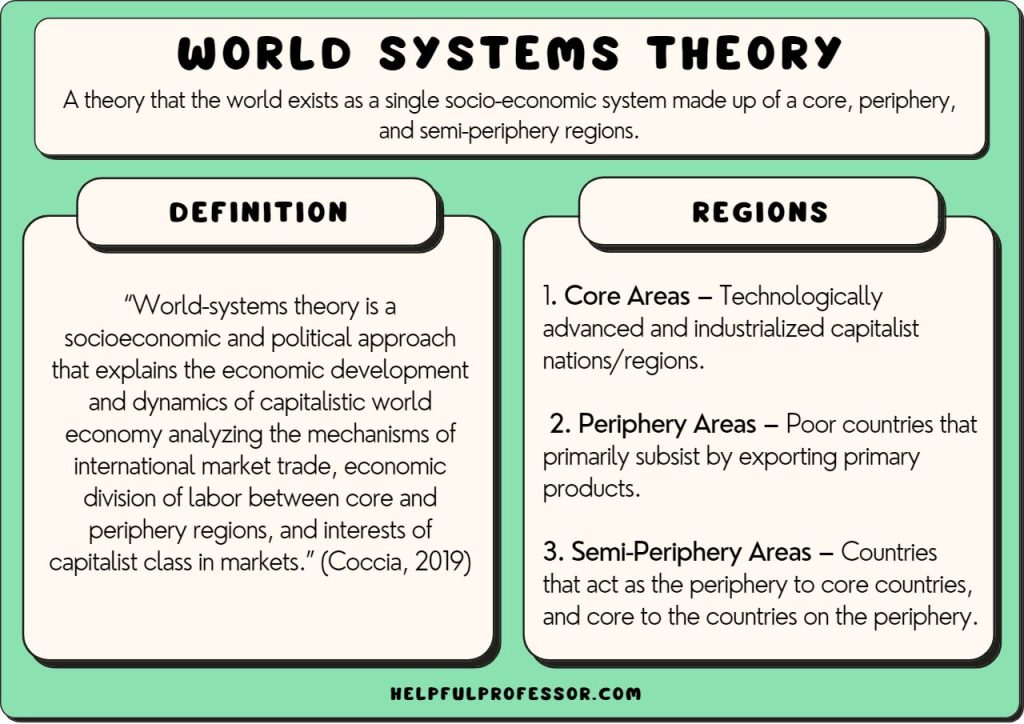The World-System Perspective - according to sociology
World-systems theory, developed by sociologist Immanuel Wallerstein in the 1970s, provides a comprehensive framework for understanding the complex interrelations of global economies and societies. This theory categorizes countries into three main groups—core, semi-periphery, and periphery—based on their economic power and roles within the global capitalist system.
## Core Concepts of World-Systems Theory
### 1. **Structure of the World System**
The world is viewed as a single economic system rather than a collection of independent nation-states. Wallerstein's model emphasizes the importance of global economic structures and how they shape the relationships between countries.
- **Core Countries**: These are economically dominant nations characterized by high levels of industrialization, advanced technology, and significant political power. Core countries exploit peripheral nations for raw materials and labor while maintaining a high standard of living. Examples include the United States, Germany, and Japan.
- **Peripheral Countries**: These nations are often less developed, economically dependent on core countries, and primarily provide raw materials and cheap labor. They typically experience lower levels of industrialization and higher rates of poverty. Many countries in Africa and parts of Latin America fall into this category.
- **Semi-Peripheral Countries**: These countries share characteristics of both core and peripheral nations. They may exploit peripheral countries while also being exploited by core countries. Examples include Brazil, India, and South Africa. They often serve as a buffer between the core and periphery, exhibiting both economic growth and poverty.
### 2. **Historical Context and Development**
Wallerstein traces the origins of the modern world system back to the "long" 16th century, around 1450 to 1640, marking the transition from feudalism to capitalism. He argues that the rise of capitalism was not a linear process but rather a complex outcome of historical developments, including colonialism and the global trade networks established during this period.
The theory builds on earlier concepts such as dependency theory, which posits that the wealth of core countries is derived from the exploitation of peripheral nations. However, world-systems theory expands this idea by incorporating a more dynamic understanding of how countries can shift between core, semi-peripheral, and peripheral statuses based on changes in global economic conditions.
## Implications of World-Systems Theory
### 1. **Global Inequality**
World-systems theory provides a lens through which to examine global inequality. It highlights how the economic exploitation inherent in the capitalist system perpetuates disparities between nations. Core countries benefit from the labor and resources of peripheral countries, leading to a cycle of poverty and underdevelopment in the latter.
### 2. **Social Unrest and Political Dynamics**
The theory also addresses the social and political implications of global economic structures. As peripheral countries struggle against exploitation, they may experience social unrest, political instability, and movements for change. This can lead to shifts in power dynamics within the world system, as some countries may rise to semi-peripheral or even core status over time.
### 3. **Critiques and Limitations**
While world-systems theory has been influential, it has faced criticism for its perceived oversimplification of complex global relationships. Critics argue that it may downplay the role of cultural factors and local contexts in shaping national development. Additionally, the rigid categorization of countries into core, semi-periphery, and periphery can overlook the nuances of individual nations' experiences and the fluidity of their economic statuses.
## Conclusion
World-systems theory offers a robust framework for analyzing the interconnectedness of global economies and the underlying structures that drive inequality and exploitation. By focusing on the world-system as a primary unit of analysis, it encourages a broader understanding of social change and economic development that transcends traditional nation-state boundaries. As global dynamics continue to evolve, the insights provided by world-systems theory remain relevant for understanding the complexities of contemporary global relations and the ongoing challenges of inequality and exploitation in the capitalist world economy[1][2][3][4][5][6][7].
Citations:
[1] https://en.wikipedia.org/wiki/World-systems_theory
[2] https://web.mit.edu/esd.83/www/notebook/WorldSystem.pdf
[3] https://www.studysmarter.co.uk/explanations/human-geography/economic-geography/world-systems-theory/
[4] https://study.com/learn/lesson/world-systems-theory-wallerstein.html
[5] https://www.sciencedirect.com/topics/social-sciences/world-systems-theory
[6] https://socialsci.libretexts.org/Bookshelves/Sociology/Introduction_to_Sociology/Sociology_%28Boundless%29/08:_Global_Stratification_and_Inequality/8.06:_Sociological_Theories_and_Global_Inequality/8.6I:_World-Systems_Theory
[7] https://revisesociology.com/2015/12/05/world-systems-theory/
[8] https://egyankosh.ac.in/bitstream/123456789/84308/1/Unit-6%20%281%29.pdf


.svg/459px-World_Systems_Theory_(Dunaway_and_Clelland_2015).svg.png)




